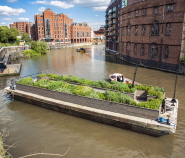
Max McClure

The Floating Ballast Seed Garden moored at Castle Park
Max McClure
Press release issued:
20 November 2012
Primary schools and community groups across Bristol are to be invited to grow their own history of the city, thanks to the award of a grant of £38,500 from the Heritage Lottery Fund, it was announced today. The University of Bristol is leading a heritage project which will encourage people to learn about the city’s trade and maritime past through growing Ballast Seed Gardens.
The University of Bristol is leading a heritage project which will encourage people to learn about the city’s trade and maritime past through growing Ballast Seed Gardens.
All the plants will be grown from seeds identified as 'incidental cargo', brought to Bristol in the ballast holds of sailing vessels from around the world in the days when the city was a major European port, particularly between the 18th and early 20th century.
Many ballast seeds have already been cultivated and grown to create a Floating Ballast Seed Garden using a disused grain barge, which is currently moored alongside Castle Park.
The public artwork has been developed as part of the Seeds of Change project which was conceived by Brazilian artist Maria Thereza Alves as part of the 2007 Arnolfini exhibition Port City. Bristol City Council and Bristol University’s Botanic Garden have since worked with the artist and Arnolfini to develop the project.
Now young people, community groups and volunteers can also explore the ideas behind the project through growing their own Ballast Seed Gardens at their school or in community spaces, alongside a series of workshops and visits to creatively explore topics that relate to science, history and art. It will include visits to the Botanic Garden, the floating Ballast Seed Garden and Arnolfini.
Martha Crean, Seeds of Change Coordinator at the University of Bristol, said: “This project offers some really fun opportunities for creative learning, from listening to the secret sounds of the inner workings of plants, to exploring plant folklore from around the world and taking a trip around the Bristol docks with a storyteller.
“The Seeds of Change project opens up new opportunities for learning outside the classroom and engaging in the cultural life of the city. It’s also a great chance to get people together to share experiences of living in Bristol and explore the connections and journeys that link us to the history of our port city.”
A special information evening is being held at Arnolfini on Thursday, 22 November, between 4pm and 6pm. For further details, please contact Martha Crean on 0117 3318313 or email martha.crean@bristol.ac.uk
For further information about Seeds of Change: Growing a Living History of Bristol, see www.bristol.ac.uk/seeds-of-change
Further information
About Seeds of Change
Working with the University of Bristol Botanic Garden, Arnolfini and Bristol City Council and utilising a disused grain barge, artist Maria Thereza Alves has created a Ballast Seed Garden on Bristol’s Floating Harbour, populated with a variety of non-native plants, creating a living history of the city’s trade and maritime past.
The design of the floating garden has been developed by German designer Gitta Gschwendtner in close collaboration with Maria Thereza Alves and Nick Wray from the Botanic Garden; Lucy Empson, landscape architect (BCC), and Arnolfini. Engineering advice courtesy of Ramboll UK, plants and materials courtesy of the University of Bristol Botanic Garden and Bristol Parks. This project has been made possible with the kind support of Bristol Harbour Authority, with funding from the Ashley, Easton & Lawrence Hill Neighbourhood Partnership.
About the Floating Ballast Seed Garden
Ballast was used to stabilise merchant sailing ships, usually stones, earth and shells, along with the seeds native to the area where they had been collected. Upon arrival in port, the ballast was unloaded and in many cases the stowaway seeds germinated. Seeds from ballast may germinate even after 200 years and they bear witness to a complex world history that is often presented in a more simplified way.
The University’s Botanic Garden has been involved from the outset, with staff and students from its Royal Horticultural Society courses raising the young plants before they were planted in the ballast seed garden display.
The plants have been selected from a list of species (researched by Maria Thereza Alves) found growing on ballast seed dumps at British ports including Bristol. The list of plants chosen for this project was carefully selected to avoid any toxic or known invasive weeds. A more extensive range of Ballast Seed Garden plants are grown in a display at the University of Bristol Botanic Garden. Both plantings will be enriched with more species as they are sourced in future years.
Spring and Summer public tours of the Floating Ballast Seed Garden are available. Please contact Arnolfini on 0117 917 2300 or email boxoffice@arnolfini.org.uk for further information.
About the Heritage Lottery Fund
Using money raised through the National Lottery, the Heritage Lottery Fund (HLF) sustains and transforms a wide range of heritage for present and future generations to take part in, learn from and enjoy. From museums, parks and historic places to archaeology, natural environment and cultural traditions, we invest in every part of our diverse heritage. HLF has supported over 30,000 projects, allocating £4.7billion across the UK. Website: www.hlf.org.uk

